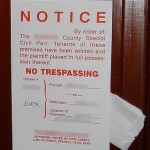As discussed in earlier posts, certain properties within the City of Los Angeles are subject to the Rent Stablization Ordinance (”rent control”). Owners of such properties are limited as to why, how and when they can evict a tenant. Below are the twelve legal reasons for evictions in the City of Los Angeles, as laid out in more detail in Rent Stabilization Ordinance Section 151.09:
1. Tenant has failed to pay rent which the landlord is entitled;
2. Tenant has violated a lawful obligation or covenant of the tenancy, other than the obligation to surrender possession upon proper notice, and has failed to cure such violation after having received written notice thereof from landlord;
3. Tenant is committing or permitting to exist a nuisance in or is causing damage to the rental unit, or to the appurtenances thereof, or to the common areas of the complex containing the rental unit, or is creating an unreasonable interference with the comfort, safety, or enjoyment of any of the other residents of the same or adjacent buildings;
4. Tenant is using or permitting a rental unit to be used for any illegal purpose;
5. Tenant, who had a written lease or rental agreement which terminated on or after the effective date of the Rent Stabilization Ordinance, has refused, after written request or demand by landlord to execute a written extension or renewal thereof for a further term of like duration with similar provisions and in such terms as are not inconsistent with or violate of any provision of the Rent Stabilization Ordinance or any other provision of law;
6. Tenant has refused the landlord reasonable access to the unit for the purpose of making repairs or improvements, or for the purpose of inspection as permitted or required by the lease or by law, or for the purpose of showing the rental unit to any prospective purchaser or mortgagee;
7. The person in possession of the rental unit at the end of a lease term is a subtenant not approved by the landlord;
8. The landlord seeks in good faith to recover possession of the rental unit for use and occupancy by:
a) the landlord, or the landlord’s spouse, children, or parents, provided the landlord is a natural person and not a corporation or partnership; or
b) for a resident manager, provided that: no alternative vacant unit is available for occupancy by a resident manager; except that where a building has an existing resident manager in order to replace her/him with a new manager;
9. The landlord, having complied with all applicable notices and advisements required by law, seeks in good faith to recover possession so as to undertake Primary Renovation Work of the rental unit or the building housing the rental unit, in accordance with a Tenant Habitability Plan accepted by the Department of Housing, and the tenant is unreasonably interfering with the landlord’s ability to implement the requirements of the Tenant Habitability Plan by engaging in any of the following actions:
a) Tenant has failed to temporarily relocate as required by the accepted Tenant Habitability Plan; or
b) Tenant has failed to honor a permanent relocation agreement with the landlord as established by the Rent Stabilization Ordinance;
10. The landlord seeks in good faith to recover possession of the rental units under either of the following circumstances:
a) to demolish the rental unit; or
b) to remove the rental unit permanently from rental housing use;
11. The landlord seeks in good faith to recover possession of the rental unit in order to comply with a governmental agency’s order to vacate, order to comply, order to abate, or any other order that necessitates the vacating of the building housing the rental unit as a result of a violation of the Los Angeles Municipal Code or any other provision of law;
12. The Secretary of Housing and Urban Development is both the owner and plaintiff and seeks to recover possession in order to vacate the property prior to sale and has complied with all tenant notification requirements under federal law and administrative regulations.
Note: Evictions under provisions #3 and #4 (when police reports and city attorneys are involved) and #8-12 require that a Landlord Declaration of Intent to Evict be filed with the Los Angeles Housing Department.
As is clear from reading the above-described twelve scenarios, the justifications for evictions in a “rent control” property in Los Angeles are fact-driven. In addition, eviction proceedings related to a “rent control” property are highly scrutinized by tenant advocate groups and the Los Angeles Housing Department (LAHD). Therefore, it is important for a “rent control” landlord to be wary of the law.


Leave a Reply